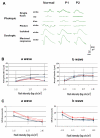Enhanced S-cone function with preserved rod function: a new clinical phenotype
- PMID: 21897746
- PMCID: PMC3164686
Enhanced S-cone function with preserved rod function: a new clinical phenotype
Abstract
Purpose: To describe the clinical findings and genetic analysis in two brothers having a novel retinal disease characterized by an enhanced S-cone phenotype with normal rod function.
Methods: Both patients underwent complete ophthalmologic examinations, including fundus photography, electroretinography (ERG), fluorescein angiography and optical coherence tomography (OCT). Mutation analysis of the following candidate genes was performed: nuclear receptor subfamily 2 group E member 3 (NR2E3), neural retina leucine zipper (NRL), nuclear receptor subfamily 1 group D member 1 (NR1D1), and thyroid hormone receptor beta (THRB).
Results: Spectral photopic ERG responses demonstrated enhanced S-cone function in both patients. Their scotopic b-wave ERG amplitude responses, however, were within normal limits. Their scotopic a-wave amplitude responses were within the lower limit of normal. The a- and b-wave latencies were normal for one sibling and on the upper limit of normal for the other. Peripheral retinal findings were normal. OCT showed flattening of the macular curvature and thinning of the photoreceptor layer. Mutation analysis of NR2E3, NRL, NR1D1, and THRB genes was negative.
Conclusions: We describe what appears to be a previously unidentified familial retinal phenotype with enhanced S-cone function and well preserved rod system function in contrast to the severely reduced rod function seen in the enhanced S-cone syndrome (ESCS). Genetic analysis of candidate genes did not reveal the cause of disease. We postulate that the disease might be caused by mutation of another, as yet unidentified gene, which encodes a protein that functions as a negative inhibitor of rod and S-cone development.
Figures


Similar articles
-
Homozygosity for a Recessive Loss-of-Function Mutation of the NRL Gene Is Associated With a Variant of Enhanced S-Cone Syndrome.Invest Ophthalmol Vis Sci. 2016 Oct 1;57(13):5361-5371. doi: 10.1167/iovs.16-19505. Invest Ophthalmol Vis Sci. 2016. PMID: 27732723
-
A novel mutation (Cys83Tyr) in the second zinc finger of NR2E3 in enhanced S-cone syndrome.Graefes Arch Clin Exp Ophthalmol. 2011 Feb;249(2):201-8. doi: 10.1007/s00417-010-1482-y. Epub 2010 Aug 20. Graefes Arch Clin Exp Ophthalmol. 2011. PMID: 20725840
-
Novel NR2E3 mutations (R104Q, R334G) associated with a mild form of enhanced S-cone syndrome demonstrate compound heterozygosity.Ophthalmology. 2005 Dec;112(12):2115. doi: 10.1016/j.ophtha.2005.07.002. Epub 2005 Oct 12. Ophthalmology. 2005. PMID: 16225923
-
Occult macular dystrophy.Jpn J Ophthalmol. 2015 Mar;59(2):71-80. doi: 10.1007/s10384-015-0371-7. Epub 2015 Feb 10. Jpn J Ophthalmol. 2015. PMID: 25665791 Review.
-
Non-syndromic retinitis pigmentosa.Prog Retin Eye Res. 2018 Sep;66:157-186. doi: 10.1016/j.preteyeres.2018.03.005. Epub 2018 Mar 27. Prog Retin Eye Res. 2018. PMID: 29597005 Review.
Cited by
-
Electroretinography and optical coherence tomography reveal abnormal post-photoreceptoral activity and altered retinal lamination in patients with enhanced S-cone syndrome.Doc Ophthalmol. 2015 Jun;130(3):165-77. doi: 10.1007/s10633-015-9487-9. Epub 2015 Feb 7. Doc Ophthalmol. 2015. PMID: 25663266
-
Suspected Enhanced S-Cone Syndrome: A Case Report.Cureus. 2023 Aug 17;15(8):e43660. doi: 10.7759/cureus.43660. eCollection 2023 Aug. Cureus. 2023. PMID: 37719593 Free PMC article.
-
Disruption of the human cone photoreceptor mosaic from a defect in NR2E3 transcription factor function in young adults.Graefes Arch Clin Exp Ophthalmol. 2013 Oct;251(10):2299-309. doi: 10.1007/s00417-013-2296-5. Epub 2013 Apr 19. Graefes Arch Clin Exp Ophthalmol. 2013. PMID: 23604511 Free PMC article.
-
Visual Cone Arrestin 4 Contributes to Visual Function and Cone Health.Invest Ophthalmol Vis Sci. 2015 Aug;56(9):5407-16. doi: 10.1167/iovs.15-16647. Invest Ophthalmol Vis Sci. 2015. PMID: 26284544 Free PMC article.
References
-
- Gouras P. The role of S-cones in human vision. Doc Ophthalmol. 2003;106:5–11. - PubMed
-
- O'Brien KM, Schulte D, Hendrickson AE. Expression of photoreceptor-associated molecules during human fetal eye development. Mol Vis. 2003;9:401–9. - PubMed
-
- Jacobson SG, Marmor MF, Kemp CM, Knighton RW. SWS (blue) cone hypersensitivity in a newly identified retinal degeneration. Invest Ophthalmol Vis Sci. 1990;31:827–38. - PubMed
-
- Marmor MF, Jacobson SG, Foerster MH, Kellner U, Weleber RG. Diagnostic clinical findings of a new syndrome with night blindness, maculopathy, and enhanced S cone sensitivity. Am J Ophthalmol. 1990;110:124–34. - PubMed
-
- Fishman GA, Peachey NS. Rod-cone dystrophy associated with a rod system electroretinogram obtained under photopic conditions. Ophthalmology. 1989;96:913–8. - PubMed
Publication types
MeSH terms
Substances
LinkOut - more resources
Full Text Sources
Other Literature Sources
Medical
